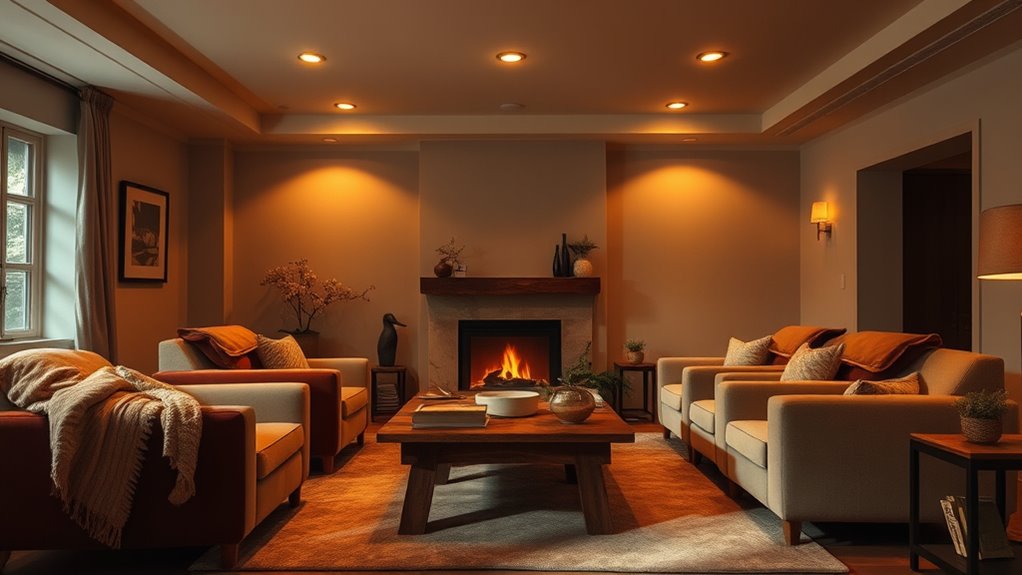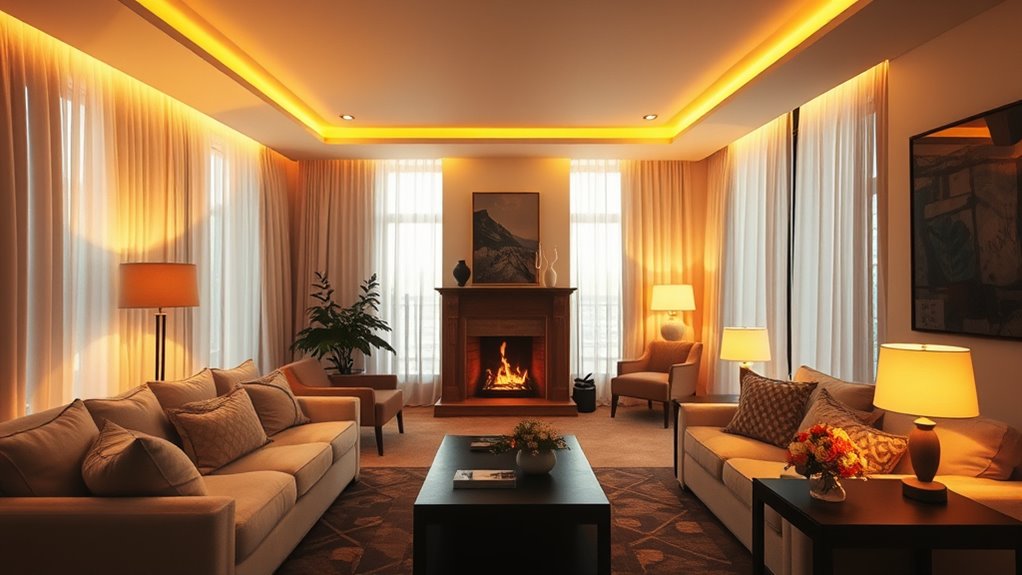Lighting plays a vital role in shaping the mood of your interior space. By choosing the right mix of natural and artificial light, you can create a cozy, energetic, or tranquil atmosphere that reflects your style. Layering ambient, task, and accent lighting gives you control over how the room feels at different times. Thoughtful placement and adjustable options help you enhance both comfort and visual appeal. To discover how to master this balance, continue exploring these lighting techniques.
Key Takeaways
- Proper lighting transforms room ambiance, influencing emotional responses and interactions.
- Natural light enhances warmth and openness, making spaces feel inviting and lively.
- Artificial lighting, including warm or cool tones, can create cozy, energetic, or tranquil moods.
- Layering ambient, task, and accent lighting provides control over atmosphere and functionality.
- Thoughtful placement and adjustable lighting techniques emphasize features and adapt to activities.

Have you ever noticed how the right lighting can completely transform the mood of a room? It’s one of the most powerful tools in interior design, shaping how you feel and interact within a space. When you’re considering lighting, you need to think about both natural light and artificial ambiance, as they work together to set the tone. Natural light floods a room during the day, bringing warmth, vibrancy, and a sense of openness. It can make a space feel inviting and lively, especially when sunlight streams through large windows or skylights. You can enhance natural light by choosing window treatments that allow sunlight to filter in without overwhelming the room. Light-colored walls and reflective surfaces also help bounce daylight around, making the space feel more expansive and energetic.
But natural light isn’t always available or sufficient, especially during evenings or cloudy days. That’s when artificial ambiance becomes vital. The right artificial lighting can mimic natural light or create entirely different moods depending on your needs. For a cozy, relaxing atmosphere, you might opt for warm-toned bulbs that cast a soft, golden glow. This type of lighting encourages comfort and intimacy, perfect for winding down after a long day. Conversely, bright, cool-toned lights can energize a space, making it ideal for work or social gatherings. Task lighting, such as adjustable lamps or under-cabinet lights, ensures you have enough illumination for specific activities without sacrificing mood. Additionally, understanding lighting techniques can help you further refine the atmosphere and functionality of your space.
You should also think about layering your lighting. Combining ambient, task, and accent lighting allows you to control the overall mood while highlighting specific features or areas. For example, dimmable ceiling lights can provide general illumination, while table lamps or wall sconces add warmth and focus to particular spots. Using dimmers gives you flexibility, letting you adjust the intensity based on the time of day or your activity. This way, you’re not stuck with a single mood but can shift seamlessly from bright and lively to soft and intimate.
Frequently Asked Questions
How Does Natural Light Influence Interior Ambiance?
Natural illumination greatly influences your interior ambiance by creating a warm, inviting atmosphere. As daylight harvesting optimizes the use of sunlight, it reduces the need for artificial lighting, making your space more eco-friendly. You’ll notice that natural light enhances colors, highlights textures, and boosts your mood. It also helps regulate circadian rhythms, making your environment more comfortable and lively throughout the day.
What Are the Latest Trends in Lighting Technology?
You’ll find that smart bulbs and LED innovations are leading the latest lighting trends. Smart bulbs let you customize color, brightness, and schedules via apps, giving you control and flexibility. LED technology continues to evolve with energy efficiency and longer lifespan, making your space both stylish and sustainable. These advancements allow you to create personalized moods, save energy, and easily adapt your lighting to suit any occasion or setting.
How Can Lighting Improve Energy Efficiency?
Ever wonder how you can cut down on energy bills? You can improve energy efficiency by using smart lighting systems that adjust brightness based on your needs and natural light, reducing waste. Switch to energy-saving fixtures like LED bulbs, which consume less power and last longer. Isn’t it satisfying to create a well-lit space while being eco-friendly? Embracing these solutions helps you save energy and contribute to a greener planet.
What Are Common Mistakes in Lighting Design?
You often make the mistake of creating hidden shadows and uneven illumination, which can disrupt the room’s balance. Avoid placing lights inconsistently or using too few fixtures, as this causes dark spots and uneven brightness. You should also steer clear of relying solely on overhead lighting, which can cast harsh shadows. Instead, layer different light sources to achieve a uniform, inviting glow and eliminate hidden shadows.
How Does Lighting Affect Perceived Room Size?
Did you know that proper lighting can make a room feel up to 50% larger? You can achieve this by playing with color temperature and shadow play; warmer tones tend to cozy up spaces, while cooler tones open them up. Strategic placement of lights creates shadows that add depth, making the room appear more expansive. Adjust your lighting to influence perception and transform your space effortlessly.
Conclusion
So, after all this, it’s funny how lighting, the very thing that should brighten your day, can also set the perfect mood—or ruin it entirely. You’d think choosing lights would be simple, but it’s almost like a secret art form. In the end, a well-lit space might seem easy, yet it’s the subtle glow that truly transforms a room. Remember, sometimes, the right lighting is what makes or breaks your mood—ironic, isn’t it?









